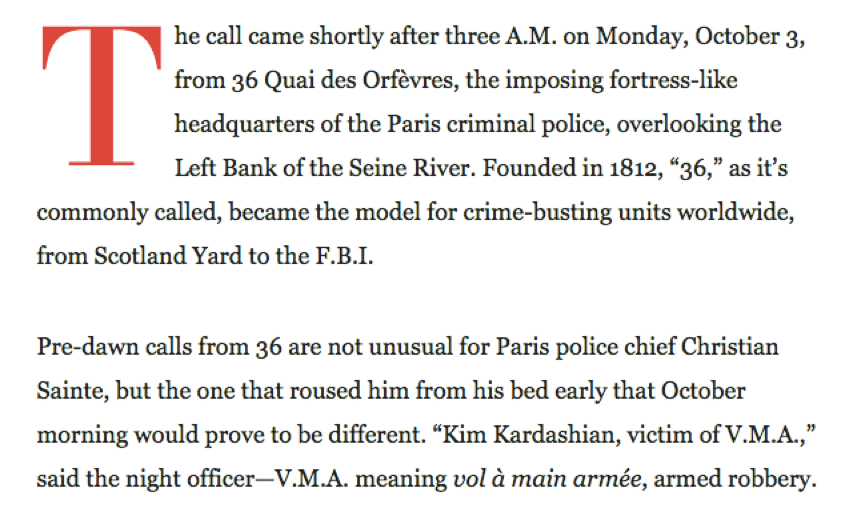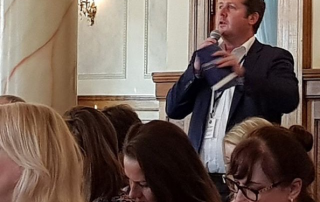Brand Newsroom 142: Mark Masters and clever content marketing for small businesses
Here are some key take-outs:
- Often small businesses are falling into content marketing because they recognise the marketplace is there for businesses to provide a value add for their audience.
- Business owners often have a hard time getting their head around the idea of “giving away” their ideas and information — yet it works.
- It can also take time to understand that a hard-sell message doesn’t work.
- Show your passion and experience for something through your content marketing and it will deliver business results for you.
- If you can find different stories — a niche — it will help you build an audience.
Here are the links you might need
- You can find Mark on Twitter here. And the Marketing Homebrew show is here.
- Mark mentioned a CB Insights report on why start-ups fail.
- Farrow and Ball’s The Chromologist website is here.
- Here’s that Trevor Young episode of Brand Newsroom Mark mentioned.
- And here’s the Brand Newsroom episode with Meesha Stacker that Sarah mentioned.
- Lush Cosmetics is here.
On My Desk
- Mark’s recommendation was an interactive music video by a band called Real Estate. You can see it (and play along) here.
- Here’s Sarah’s recommendation, an article by Cornwall SEO’s Lyndon Antcliff.
Have you heard the one about…
Recently James, Sarah and Nic took a close look at marketing for multiple brands, with Sandra Brewer.
And here’s a (rather heated) debate the team had about marketing awards and whether they’re worth the effort.
Like what you’ve heard?
Give us a follow on Soundcloud to get the latest episodes.
Or, you can subscribe or leave a review on iTunes.
Brand Journalism: How to write a good lede
It’s easy to suck.
Getting that first sentence right — finding the perfect words to capture the reader’s attention and hold it — can be tricky.
For some of us, it’s a delicious challenge. Do I paint a picture or hit them with the facts? Do I metaphorically punch the reader in the gut? Or do I woo them into the story gently?
For others, finding the right words to start an article (or a blog post or a newsletter or a letter to Great-aunt Joan) comes somewhere on the pain chart between diving into a hornet’s nest and pouring acid into their eyes.
So, what’s the secret to writing a good lede?
Start with the basics
If writing doesn’t come naturally to you, there’s one tried and tested method used by journalists the world over — the “inverted pyramid”. (This is the advice you’ll get everywhere on the internet, but I’m going to build on this a little later).
The idea here is to put the most important information first and then each sentence thereafter contains the next most important information (So the pyramid is fat at the top, where the meaty facts are, and skinny down the bottom where the least important information is found.)
The most important information is almost always the stuff that answers the questions:
- Who?
- What?
- When?
- Where?
And, often somewhat less so:
- Why?
- How?
Just getting this information down in a sentence is usually a good place to start. It means the page is no longer a blank white sheet staring back at you, mocking your ability to write. These can be relatively simple sentences, but they are crammed with information.
Let’s take a story from the Zeitgeist and see how the journos do it, before we get down to how brand journalists can use the same technique. This is from the Daily Mail.
The opening sentence gives you the basics of the story, so you can quickly tell what it’s about and decide whether you want to read on. If you do read on, then you get the next most important information, and on it flows through the article. This is where the writer answers in more depth the questions:
- Why?
- How?
So, does the ‘inverted pyramid’ work for brand journalism?
Of course it does. If you’re doing brand journalism properly then you’re not writing to sell anything, you’re writing to give your audience valuable and relevant information. If you’re trying to shoehorn a sales message into your copy, then you’re doing content marketing all wrong. At that point, you’re a copywriter. (Which is a fine skill, but it’s not brand journalism.)
Everything you write as a brand journalist should be written with the audience in mind. So why wouldn’t you write your lede the way a journalist would write theirs? After all, your audience wants the “who, what, when, where, why, how” questions answered, too, right?
Mix it up a bit
Not every story a journalist (or brand journalist) writes starts the same basic way. The following examples are great ways to mix things up a bit — starting from the easiest to achieve and ending with the hardest.
First, take a look at this article from the BBC.
The writer could have written the “who, what, when, where, why” introduction. They could have written:
“Kim Kardashian has spoken about being robbed at gunpoint in Paris last year in an interview on the Ellen DeGeneres Show”.
It would be completely accurate and perfectly acceptable. But the story becomes more interesting when you put a human angle in the opening sentence. In this case, the BBC journalist has told us how the robbery affected Kardashian, then she’s gone on to give us the “who, what, when, where, why” information in the next two sentences.
Often I’ll start with a traditional “who, what, when, where, why” introduction, get the whole story written, and then I’ll go back up to the top and put a new sentence before the introduction, to add a bit of emotion or interest, in just the way this article has done. After all, sometimes the bare facts of the story aren’t the most interesting point — they aren’t the things that tell the best story.
All that information in the original opening sentence is still important (and you’ll use it, probably slightly reworded, in the next couple of sentences) but sometimes you want to give the reader a different experience, to entice them into the story rather than just hit them with facts. This is a simple technique that helps you achieve that.
Tease the reader
Another option is to appeal to the reader’s curiosity, like this article from the Mirror.
If you’re interested in Kim Kardashian, you’re going to want to know how she felt, so you’ll read on. And here’s what’s in the next couple of sentences of that story:
Once again, the “who, what, when, where, why” stuff comes next. You don’t actually find out how Kim felt until the next sentence — four paragraphs into the story. A tease like this is a great way to get a reader hooked into a story and draw them closer to your call to action.
Get creative (where it suits the story)
Once you have confidence with these sorts of techniques — once you’ve dabbled a bit with more creative introductions — you can really go for broke. Eventually, you’ll be skilled enough to go “Full Vanity Fair” — where the story is told in such an intoxicating way that, even though you hate Kim Kardashian, you can’t help but read it because the writing is so engaging.
This article spends ages telling the story of the night Kim Kardashian was robbed, but from a completely different perspective. It’s such a great idea. A great lede can catch the eye for many different reasons, but giving the reader a completely new twist, something fresh, is a great way to engage them.
Knowing what style to use
Whether you go in with the hard facts, the “who, what, when, where” question, or get more creative, is really up to you and the demands of your audience. Consider whom you’re writing for, how they consume their information, and which approach will work best for the article you’re writing. You should also consider when you’re going to publish it. Is it during the week, when your audience is likely to be busy? Or is it on the weekend, when they might have time to sit down and read the 2000-word “Vanity Fair” version?
I’ve used a news story as the example here because it’s hard to find four or five articles about the same topic within (for example) accounting, or spectacle retailing, or mining industry recruitment that are all written with such journalistic range. But, of course these techniques work just as well in brand journalism as traditional journalism. The constants here are:
- The need to impart important information
- The desire to tell a good story
- The demands of the audience.
It doesn’t matter if you’re writing about the latest bifocals or the government’s new taxation regulations; you always need to meet those three factors. Being able to write a good lede gives you the best possible chance of the article succeeding. In other words, it might suck to write a lede, but it doesn’t mean the lede has to suck.
If you’d rather someone else wrote your ledes for you, Lush Digital Media can take the pressure off. We have an expert team of journalists and editors who love doing this (way more than they love Kim Kardashian, we promise). Get in touch.
Like what you’ve read? Sign up to the Lush newsletter for fortnightly advice to help you market your business better, tips from our video production gurus, and a podcast or two from our favourite podcasting team, Brand Newsroom. In the meantime, you might enjoy these:
Guaranteed ways to unleash your inner creative beast
The secret to effective writing for business
Brand Newsroom 141: Sandra Brewer on how to manage messaging for multiple brands
Our guest this week is the director of Perceptive Marketing, Sandra Brewer, who joins the BNR team to talk about how to manage marketing for a portfolio of brands.
This to answer to a question from a listener, Adrian Jones, who noted that companies with multiple brands must have to treat marketing for their consumer-facing brands very differently to their corporate brand — as they have completely different audiences. It led to a really interesting conversation.
Here are some key take-outs:
- Whether you have one brand or a portfolio of brands is a decision based on two factors:
- Audience. If you have separate audiences with distinct needs, then it’s worth having separate brands.
- Efficiency. If there’s a commonality between the audiences, then it’s far more cost-effective to have one brand.
- Sandra worked for Mars for many years. When we hear Mars we think of chocolates, like Snickers and M&M’s, but the company also sells pet food and pasta sauces — obviously these needed to be separate brands. But separate brands within the chocolate portfolio allow Mars to target separate audiences, too.
- Sandra says: “Strive for one brand, if you can: The strength is there in one brand. If you’re standing for something that’s above the category, which is an idea — which is what we aspire for all brands — then you can have breadth.” She gives the examples of Apple and Virgin. “If you can build your brand on an idea, then you can meet your needs across a number of categories”.
- For dealing with the media, particularly in moments of crisis communications, having separate brands can be a good strategy to help isolate separate products from the fallout of negative publicity.
- Treat your consumer and corporate brands with absolute consistency.
On My Desk
- Sandra recommended the Positioning Roulette
- Sarah recommended this video about choosing the right font.
- Nic mentioned a survey of Australia media he’s recently carried out. One of the findings was that 84 per cent of reporters, producers and editors prefer to be contacted by a short “snippet” email, with a follow-up phone call a couple of hours later. More results to come soon.
Have you heard the one about…
Recently James, Sarah and Nic looked at the take-outs from Nic’s Meet the Media series of events. If you deal with the media at all, it’s worth a listen.
And the team also got a bit passionate recently when asking the question “are marketing awards really worth the effort?”
Like what you’ve heard?
Give us a follow on Soundcloud to get the latest episodes.
Or, you can subscribe or leave a review on iTunes.
Brand Newsroom 140: Meet the Media Follow-up
Every year Brand Newsroom host Nic Hayes runs a series of events, called Meet the Media, around Australia’s capital cities. It’s a fantastic concept that allows brands to meet journalists and editors from major media outlets and find out how they can work with them more effectively. Needless to say, it’s hugely popular. Today, Nic, James and Sarah discuss the take-outs from this year’s series.
Here are some key points about how brands should deal with the media if they want to be successful in getting coverage in mainstream media outlets:
- Don’t pitch the product or the service; pitch the story.
- You aren’t courting the media; it’s a transaction that’s taking place.
- Each journalist, producer, editor or presenter has a preferred channel of contact and content delivery.
- Do your research on your target media. Make sure you address the correct person and get their name and title right.
- Get straight to the point.
On My Desk
- Sarah recommended the podcast The Managing Editor Show.
Have you heard the one about…
Recently James, Sarah and Nic took a close look at marketing awards, and whether they’re worth entering.
And here’s a fascinating and really informative discussion about media intelligence (what we used to call “media monitoring”) and how it’s changing.
Like what you’ve heard?
Give us a follow on Soundcloud to get the latest episodes.
Or, you can subscribe or leave a review on iTunes.
Content Marketing: How to run an editorial calendar
When I was a cadet reporter things were still distinctly analogue, so my editorial calendar was kept on a notepad, a week to a page.
It was crude, but efficient. I had planned out in front of me, for as many weeks ahead as practical, precisely what I needed to write for each week’s newspaper. I knew who was being interviewed, what photos were needed, what my deadlines were — everything.
These were the days when the entire newsroom had one email address between us and we fired up a special computer, once a week, to check them. I mean, receiving a fax was about as cutting edge as we needed to be in order to speak truth to power and hold the local council to account.
Nowadays our editorial calendars are most definitely digital — and they’re filled with concepts we’d never even heard of back when I was scribbling into my notepad: Tweets, Facebook, LinkedIn. But the principle is very much the same. If you want to keep track of your content, then it is vital to run an editorial calendar.
Your calendar doesn’t have to be complicated. In fact, the simpler the better. I use a spreadsheet, rather than a fancy computer program, because at heart I’m still that very analogue 19-year-old cadet. But whether it’s a razzle-dazzle whiz-bang management system with automated social media posting and integrated doodads, a spreadsheet, or a pad and a pen, here’s what an editorial calendar should look like.
It should look like an actual calendar
Just like you use your diary to keep track of your appointments, an editorial calendar should be broken down methodically into days, weeks, months and years, so you can see precisely:
- What was published on what day in the past
- What you plan to publish on what day in the future
- Where there are gaps that need to be filled with content
- Whether you’re getting the mix of content right.
It should tell you where every piece of content is at right now
But it’s not enough that a calendar should be a list of publication dates. Your calendar should also keep track of what content is under consideration; has been commissioned; is in production, being edited, proofed, or approved; and has been scheduled for publication.
What’s more, if you’re working in a team, it’s important to keep track of who is in charge of each piece of content at every single stage of your editorial process. If you don’t know whether the article due for publication on Monday is still being written, is with your proofreader, or is being held up during the client approval stage, then you could waste ages trying to track it down.
Everyone who needs it should have access to it
Your editorial calendar should be your central point of communication for your newsroom. Everyone involved in the production of content who might need to refer to the calendar should have access to it — you, your writers, the client, the marketing manager, and so on. Not everyone should be able to edit it, of course, but anyone who might need to see it should be able to. You’ll be amazed how much emailing backwards and forwards a well-run editorial calendar can save.
The other really important thing is that one person should be in charge of the calendar — whether that’s an account manager, the editorial lead, or someone else. An editorial calendar is a bit like a cruise ship — it will sail along nicely without the captain for a while, but eventually it’s going to run aground without someone there to steer it.
It should link out to the published content
Your editorial calendar gives you a picture of the future, the present and the past, all at a glance. It becomes a wonderful resource to help you answer questions like “didn’t we write a blog about…?” and “when did we run that article on…?” So include URLs so you can quickly find your way back to the content, even if it’s years after it has been published. You should also have a way to link back to the original content within your company filing system, too. Life is much easier when you can find the original word document or video.
If you’re running your newsroom for a client, your editorial calendar also becomes a handy one-stop shop for invoicing. Don’t underestimate the value of that.
Each editorial calendar will look a little different
In my role as managing editor at Lush Digital Media, I regularly deal with more than a dozen editorial calendars. Each one looks slightly different to the others — and that’s OK, because our clients have different needs, wants and priorities. The important thing is that the calendar provides us with whatever information that I, my team, and our clients, might need at any given moment.
If you want to work with a content agency and video production house that understands the importance of running a strong editorial calendar in achieving your content marketing goals, get in touch with Lush Digital Media.
Like what you’ve read? Sign up to the Lush newsletter for fortnightly advice to help you market your business better, tips from our video production gurus, and a podcast or two from our favourite podcasting team, Brand Newsroom. In the meantime, you might enjoy these:
Why being reactive should be part of your strategy
The secret to effective writing for business
A brand journalism approach to growing your audience
Brand Newsroom: How to generate editorial ideas like a journalist
Brand Newsroom 138: Media Intelligence: Here’s what you need to know
We’ve come a long way from the days when “media monitoring” involved a ream of paper clippings and transcripts turning up on the boss’s desk each morning. Technology has changed everything.
Media monitoring has evolved into “media intelligence”. To help us understand what that can do for our brands, the BNR team is joined by MyMedia Intelligence co-founder, Paul Chapman.
Here are some key take-outs:
- According to Paul, “media intelligence is the identification, selection and delivery of smart, relevant news content”.
- Aggregation software is used to find news, voice-to-text software follows broadcast media, and real people then sift through it all to give the most important items to their client. It means media monitoring services can get to clients much sooner than it used to be.
- Some clients monitor themselves; some monitor their competition, too. Others also monitor the issues they’re interested in.
- Monitoring social is more important than ever but many clients still don’t do it because of their own cultural reasons (they’ve only ever monitored newspapers, for example) or because they don’t have social media accounts so don’t think they need it.
- It’s now important to monitor influencers, too. And media intelligence can help brands be on the front foot with this — by identifying influencers brands should be working with.
- Media intelligence isn’t just looking at the coverage that has been received, it’s forward-looking, too. The analytics now available can be used to help brands make decisions going forward.
- Traditional media mentions help legitimise a brand. Once you’ve been mentioned, you need to amplify it.
- Knowing they’re about to be mentioned in the media, using media intelligence, brands can respond in real time, rather than being behind the eight ball.
On My Desk
- Paul took a look at the latest West Australian radio ratings and noted that talkback radio ratings were down during the recent State Election — so where were people consuming their news on that event? There’s a take-out for that for every brand: know where you audience is consuming its news.
- Nic mentioned the success he’d had selling tickets to his Meet the Media event by advertising it on Facebook, even though he didn’t put a call to action in the ad. Awareness, he said, was enough to encourage people to buy because the event is a good value proposition.
- Sarah’s recommendation was a service called Mention, which is useful for smaller brands that might be interested in media monitoring but don’t have a big budget.
- James recommended NPR’s Hidden Brain podcast.
Here are the links you might need
- You’ll find Paul Chapman’s MyMedia Intelligence here.
Have you heard the one about…
Recently James and Sarah took a close look at the questions brands should ask before they engage an agency.
And here’s a discussion about how virtual reality is opening up new ways for brands to connect with their audience.
Like what you’ve heard?
Give us a follow on SoundCloud to get the latest episodes.
Or, you can subscribe or leave a review on iTunes.




















